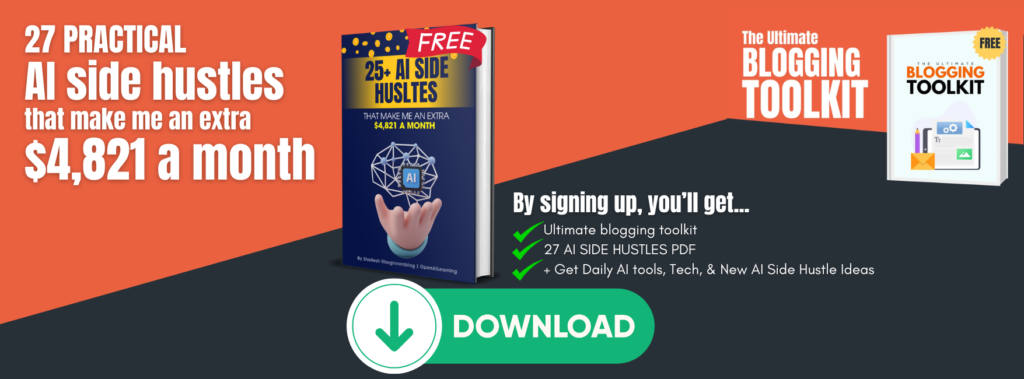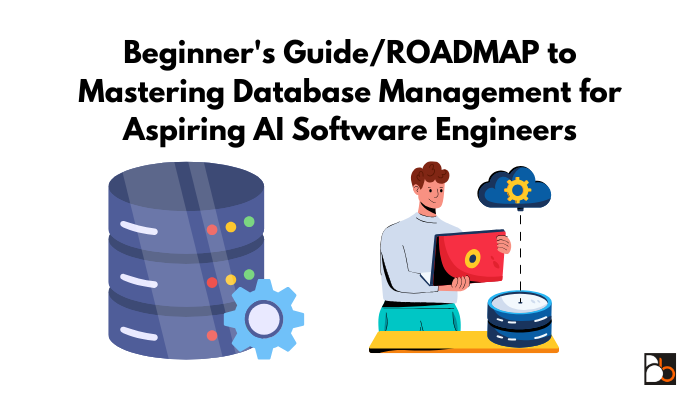Database management is a cornerstone skill for AI software engineers. Whether you’re building machine learning models or scaling AI systems, understanding how to design, implement, and optimize databases will elevate your career. This guide breaks down essential database concepts, skills, tools, and actionable steps to transition from a beginner to a high-paying professional, with practical recommendations for courses and modern tools.
Chapter 1: Understanding Databases
What is a Database?
- A database is a system to store, organize, and retrieve data efficiently. It’s foundational to managing structured and unstructured data.
- Types of Databases:
- Relational (SQL): Structured, tabular data. Examples: MySQL, PostgreSQL, SQLite.
- NoSQL: Semi-structured/unstructured data. Examples: MongoDB, DynamoDB, Firebase.
- Graph Databases: For connected data. Examples: Neo4j, ArangoDB.
- Cloud Databases: Highly scalable. Examples: AWS RDS, Google BigQuery, Azure SQL.
Why Databases Matter in AI?
- Data Accessibility: Databases enable streamlined data preprocessing for AI/ML pipelines.
- Real-Time Decision Making: Supports applications like fraud detection and personalized recommendations.
- Scalability: Manages the vast amounts of data AI models require.
Essential Concepts to Learn:
- Schema Design: How data is structured.
- Transactions: ACID properties (Atomicity, Consistency, Isolation, Durability).
- Indexes: Enhance query performance.
- Data Partitioning: Break large datasets for efficiency.
Recommended Tools for Beginners:
- MySQL (Relational): Easy-to-use, widely adopted.
- PostgreSQL (Relational): Advanced features for complex queries.
- SQLite: Lightweight, embedded databases for prototyping.
- Neo4j: Explore graph databases for AI-related use cases.
Recommended Beginner Courses:
- Coursera: “Databases and SQL for Data Science” (IBM).
- EdX: “Introduction to Databases” (Stanford Online).
- Udemy: “SQL for Beginners” by Jose Portilla.
Chapter 2: Getting Started with SQL
SQL is the backbone of data management in relational databases, essential for AI engineers to retrieve and analyze structured data.
Why Learn SQL?
Hands-On Tools to Practice SQL:
- SQLZoo: Interactive SQL tutorials.
- Mode Analytics: Query real-world datasets.
- HackerRank SQL Challenges: Practice SQL problem-solving.
Core SQL Concepts:
- Data Definition Language (DDL): CREATE, ALTER, DROP commands for database schema management.
- Data Manipulation Language (DML): INSERT, UPDATE, DELETE for data handling.
- Data Query Language (DQL): SELECT to retrieve data.
- Joins and Subqueries: Combine and filter datasets efficiently.
Practice Exercises:
- Create a database for managing user profiles, including fields like UserID, Name, Email, and Preferences.
- Write SQL queries to:
- Retrieve all users who joined in the last month.
- Identify users with overlapping preferences using JOIN.
- Aggregate user data for generating insights (e.g., GROUP BY).
Recommended Resources:
- Books:
- SQL in 10 Minutes, Sams Teach Yourself by Ben Forta.
- Courses:
- Coursera: “Databases and SQL for Data Science with Python” (UC Davis).
- Udemy: “SQL for Data Analysis: Advanced SQL Querying Techniques”.
- Practice Platforms:
- LeetCode SQL Questions: Prepare for interviews with real-world challenges.
Chapter 3: Introduction to NoSQL Databases
What is NoSQL?
NoSQL databases manage semi-structured and unstructured data, ideal for AI and real-time applications where relational databases may not be efficient.
Types of NoSQL Databases:
- Document-Oriented: MongoDB, Couchbase.
- Key-Value Stores: Redis, DynamoDB.
- Column-Oriented: Apache Cassandra, HBase.
- Graph Databases: Neo4j, Amazon Neptune.
Latest Use Cases in AI:
- Recommendation Engines: Leverage graph databases for user connections and preferences.
- Real-Time Analytics: Use Redis or DynamoDB for caching and session management.
- IoT and Big Data: Manage high-velocity data streams using Cassandra or HBase.
Essential Techniques for NoSQL:
- Sharding: Distribute data across multiple nodes for scalability.
- Data Replication: Ensure high availability and fault tolerance.
- Schema Design: Plan for flexible structures to accommodate evolving data.
Tools and Resources:
- MongoDB Atlas: Managed cloud NoSQL solution.
- Neo4j Sandbox: Try graph database use cases.
- Cassandra Training: Hands-on experience with scalable NoSQL systems.
Action Plan:
- Install MongoDB locally or use its cloud service (Atlas).
- Design a simple NoSQL project such as a product catalog.
- Practice querying data using the MongoDB Aggregation Framework.
- Explore graph-based connections using Neo4j for relationship data.
Recommended Courses:
- MongoDB University: MongoDB Basics.
- Udemy: “The Complete Developers Guide to MongoDB” by Stephen Grider.
- Coursera: “Introduction to NoSQL Databases” by IBM.
Chapter 4: Building Your First Database Project
Project Idea: E-Commerce Data Management System
Build a database to manage orders, users, products, and transactions in an e-commerce platform.
Schema Design:
- Relational:
- Users Table: UserID, Name, Email.
- Products Table: ProductID, Name, Price.
- Orders Table: OrderID, UserID, OrderDate.
- OrderDetails Table: OrderID, ProductID, Quantity.
- NoSQL (MongoDB):
- Design a single Orders collection embedding user and product details.
Action Steps:
- Relational Workflow:
- Use MySQL or PostgreSQL for schema-based database design.
- Normalize data to 3NF for efficient storage.
- Write SQL queries to calculate sales and generate order history.
- NoSQL Workflow:
- Use MongoDB to create flexible document collections.
- Implement queries to retrieve and aggregate sales data.
Integration and Deployment:
- Use Python’s pymysql or pymongo libraries to connect your database to a Flask/Django backend.
- Host your application using services like AWS, Heroku, or Google Cloud.
Advanced Features:
- Data Caching: Use Redis for frequently accessed queries.
- Full-Text Search: Implement Elasticsearch for product search functionality.
- Analytics: Build dashboards using Tableau or Google Data Studio.
Recommended Resources:
- Udemy: “SQL for Data Analysis: Beginner MySQL Business Intelligence”.
- Coursera: “Data Engineering with Google Cloud” (Google Cloud).
Chapter 5: Advanced Topics for AI Engineers
1. Database Normalization and Denormalization
- Normalization: Organize data to minimize redundancy and improve efficiency.
- Key Concepts:
- First Normal Form (1NF): Eliminate duplicate columns and ensure atomicity.
- Second Normal Form (2NF): Remove subsets of data that apply to multiple rows.
- Third Normal Form (3NF): Eliminate transitive dependency.
- Use Case: Use in applications where data integrity is critical, like financial systems.
- Key Concepts:
- Denormalization: Combine tables to improve read performance in data-intensive applications.
- Use Case: Analytics dashboards or data warehousing.
2. Indexing and Query Optimization
- Indexes: Create indexes on frequently queried columns to enhance performance.
- Types of Indexes:
- Single-column, multi-column, and full-text indexes.
- B-tree and hash-based indexes for different use cases.
- Tools to Learn: Use EXPLAIN or EXPLAIN ANALYZE to debug and optimize queries.
- Example Tool: PostgreSQL Query Planner.
- Types of Indexes:
- Optimization Techniques:
- Minimize the use of SELECT *.
- Use database views for frequently used queries.
- Analyze and rewrite slow queries using tools like pg_stat_statements.
3. Distributed Databases and Big Data Tools
- Distributed Systems: Manage massive, distributed datasets with high availability.
- Examples:
- Hadoop: Batch processing for big data.
- Spark: Real-time big data processing.
- Google BigQuery: Scalable cloud data warehousing.
- Examples:
- Real-Time Analytics: Use Kafka for data streaming and Elasticsearch for full-text search.
4. Best-in-Class Tools to Master
- Cloud Platforms: AWS Redshift, Snowflake, Azure Synapse.
- ETL Tools: Apache NiFi, Airflow for data pipelines.
- Monitoring: Use Prometheus and Grafana for database monitoring.
Recommended Advanced Courses
- Coursera: “Data Engineering, Big Data, and Machine Learning on Google Cloud” by Google.
- EdX: “Building Cloud Computing Solutions at Scale Specialization” by Duke.
- Udemy: “The Ultimate Guide to Query Optimization”.
Chapter 6: Best Practices for Professionals
1. Data Security and Compliance
- Encryption: Implement data-at-rest and in-transit encryption with tools like pgcrypto (PostgreSQL) or AWS KMS.
- Access Control: Define role-based access controls (RBAC).
- Compliance Standards:
- GDPR: Protect personal data for European citizens.
- HIPAA: Secure sensitive health information.
2. Version Control for Databases
- Tools like Liquibase or Flyway to manage database schema changes.
- Best Practices:
- Implement database migrations in CI/CD pipelines.
- Track changes with version control systems (Git).
3. Cloud-Native Database Solutions
- Amazon Aurora: High-performance managed relational databases.
- Google Cloud Firestore: Serverless NoSQL database.
- Azure SQL Database: Auto-scaling and serverless options.
Recommended Certifications
- AWS Certified Database Specialty: Covers relational and non-relational databases.
- Google Professional Data Engineer: Includes real-world data processing workflows.
- Microsoft Azure Data Engineer: Focuses on modern data platform solutions.
Chapter 7: Building Your Portfolio
1. Create Standout Personal Projects
Showcase your expertise through real-world, impactful projects. Select projects that highlight the skills required for AI software engineering and database management.
Project Ideas:
- AI-Powered Recommendation System:
- Build a movie or product recommendation engine.
- Use PostgreSQL or MongoDB for database storage and connect with a machine learning pipeline in Python.
- Example: Predict user preferences based on historical data.
- IoT Sensor Dashboard:
- Collect and store sensor data in real-time using NoSQL databases like DynamoDB.
- Create a visualization dashboard using Python Dash or Tableau.
- Data Warehouse Design:
- Design a data warehouse for business analytics using Snowflake or Google BigQuery.
- Implement ETL pipelines using Apache Airflow.
Key Features to Include:
- Integrate a secure authentication system (e.g., Firebase Auth).
- Implement data caching with Redis to improve performance.
- Showcase RESTful APIs for data access.
2. Develop Open-Source Contributions
- Join open-source projects on GitHub related to data management.
- Examples:
- Improve the performance of an existing database module.
- Create a library or plugin for popular tools like PostgreSQL or MongoDB.
- Platform for Open-Source Collaboration:
- GitHub: Explore trending repositories.
- Kaggle: Collaborate on machine learning and database challenges.
3. Build a Personal Portfolio Website
- Use frameworks like Flask, Django, or React to showcase your skills and projects.
- Include:
- A blog section to discuss database management trends.
- Links to GitHub projects.
- Visual dashboards or tools you’ve built.
4. Recommended Certifications
- Google Professional Data Engineer Certification: Validate your cloud database and data pipeline skills.
- AWS Certified Database Specialty: Gain in-depth knowledge of managed databases.
- Microsoft Azure Data Engineer Associate: Learn modern data solutions.
Recommended Resources to Build Your Portfolio:
- Udemy: “Build a RESTful API with Python and Flask” by Jose Salvatierra.
- Coursera: “Cloud Engineering with Google Cloud”.
- EdX: “Professional Certificate in Cloud Computing”.
Chapter 8: Transitioning to a Professional Role
1. Build a Strategic Network
- Engage Online: Participate in database-related communities like:
- Stack Overflow
- LinkedIn Groups focused on AI and database technologies.
- Attend Events:
- Conferences: AWS re:Invent, Google Cloud Next, Data Council.
- Hackathons: Compete in database-focused challenges to gain exposure.
2. Perfect Your Resume and Portfolio
- Action Steps:
- Highlight your certifications prominently.
- Include specific projects showcasing database management and AI integration.
- Use action verbs like “optimized,” “engineered,” and “streamlined” to describe your accomplishments.
3. Apply Strategically
- Job Platforms:
- AngelList for startup roles.
- LinkedIn for corporate positions.
- Stack Overflow Jobs for tech-centric roles.
- Tailored Applications:
- Focus on roles mentioning SQL, NoSQL, data pipelines, or AI.
4. Master Technical Interviews
- Topics to Prepare:
- Database schema design challenges.
- Writing and optimizing SQL queries.
- System design questions integrating databases.
- Recommended Practice Tools:
- HackerRank: Advanced SQL and database management problems.
- LeetCode: Technical challenges tailored for database roles.
- Interview Query: Specializes in data science and data engineering interview prep.
Conclusion
With a comprehensive roadmap and actionable steps, you now have all the tools to transition into a professional database manager and AI software engineer. By mastering modern tools, completing relevant projects, building an impressive portfolio, and acing interviews, you’re positioned to secure high-paying roles and advance in this dynamic field.






